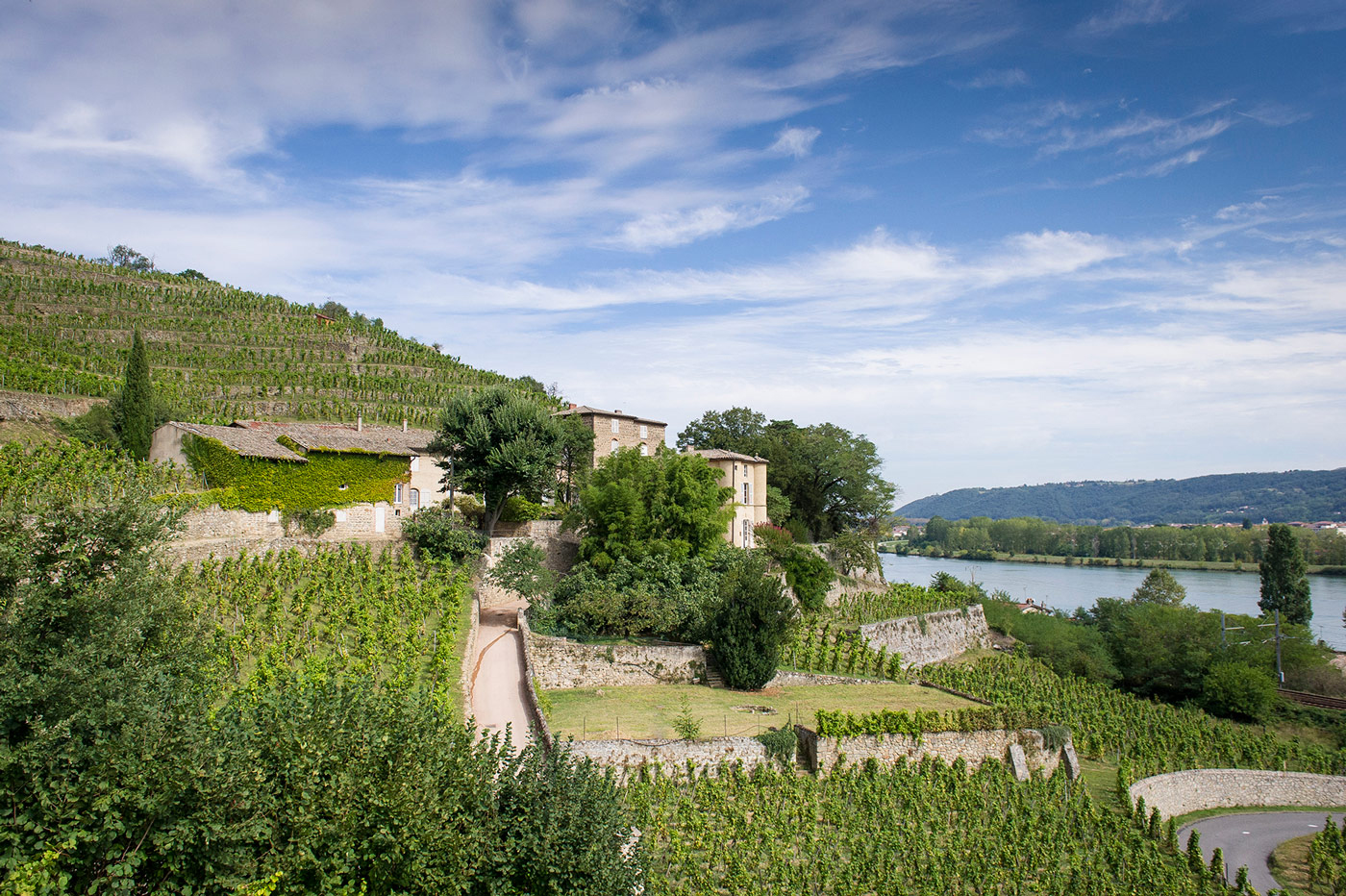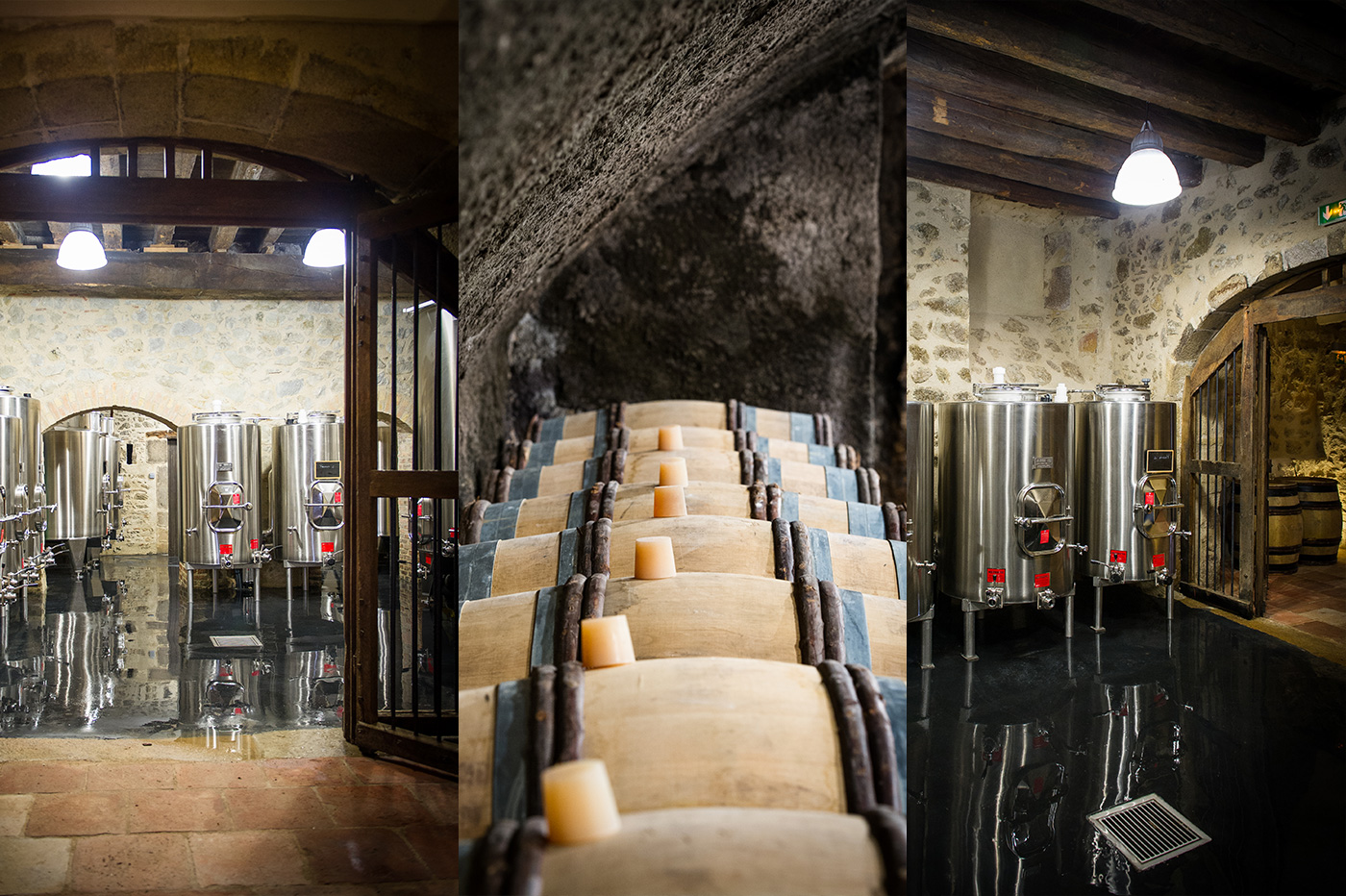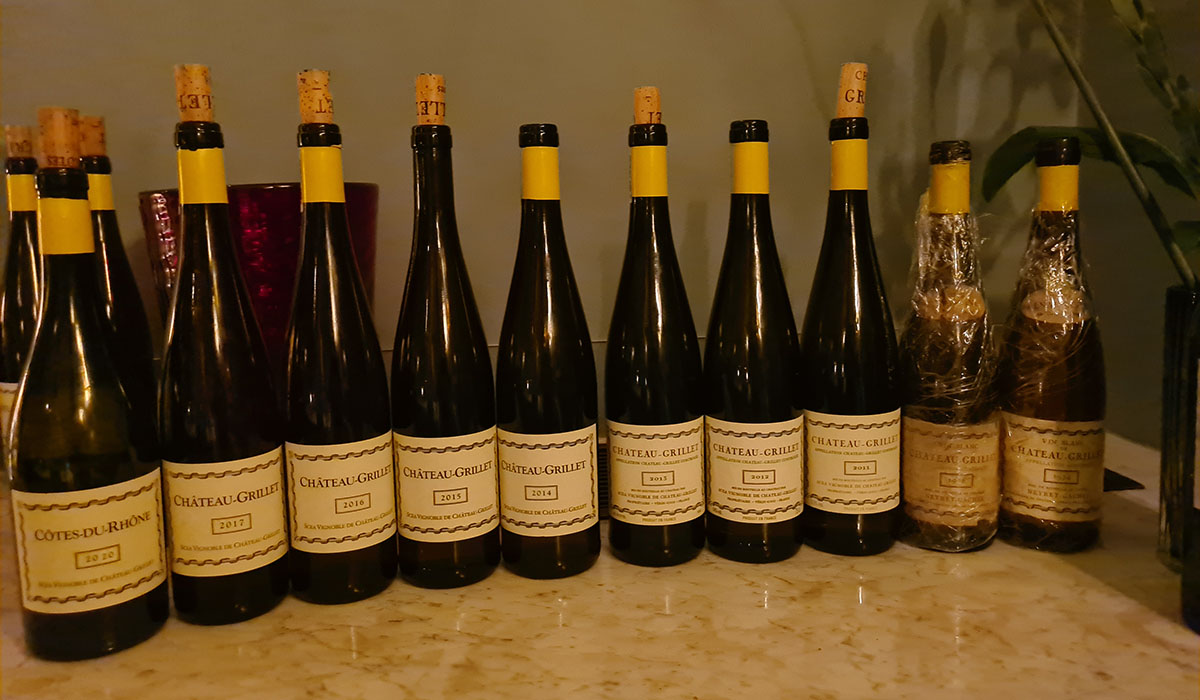
You have to see Château Grillet to truly appreciate it. An amphitheatre of terraced vines is carved into the perilously steep slopes overlooking the Rhône river. The small property sits below the majority of the vineyard, with lower terraces spreading right and left, and some new plantings curling away upriver towards Lyon.
Production is small – the entirely-Viognier vineyard is 3.75 hectares in size, and only a percentage of this makes the cut to become the flagship bottling. Though planted to the same variety as adjacent Condrieu, this monopole appellation makes wines that are a style of their own, ageing wonderfully in ways most Viognier simply cannot. Often the wines need time in bottle to open up, in great contrast to most Condrieus which are at their best almost from the moment they are bottled. The name itself suggests why – grillet, or burned, refers to the suntrap that is the south-facing vineyards here. This spot of land has its own microclimate that sets it apart. Vine material and soil are also unique, something of key importance to the new(ish) owners.

In 2011 Château Grillet became part of the Artemis group, owned by Francois Pinault and run by Frédéric Engerer. This put significant experience into the property, with the group also running Château Latour, Domaine d’Eugenie, Clos de Tart and Eisele Vineyard in Napa, among others. It also allowed for significant investment to take place. The drystone walls have been repaired and meticulously maintained. The vines have been retrained to improve quality and mitigate disease risk, with new plantings added and viticulture improved. Conversion to biodynamic farming has been completed. The tiny winery has been given all necessary upgrades, allowing each plot to be picked, pressed and vinified separately. Ageing takes place in barrel for 18 months, though the percentage of new oak has been reduced to 20%. The team has been expanded and renewed to ensure the greatest expertise and work ethic. Strict selection in vineyard and winery has increased production of a Côtes du Rhône white – formerly Pontcin – that offers a glimpse of the style and raises the level of the tiny production of Grillet itself. There is, too, a Condrieu called La Carthery, coming from two plots acquired in 2013 and 2017 respectfully that total a tiny 0.25 hectares.
Alessandro Noli ran the operation at Grillet until his move to run Clos de Tart for Artemis in Burgundy. Jae Chu is now the lead winemaker here, having worked within the Artemis group alongside her personal projects for some time. Originally from South Korea, she moved to Burgundy in 2008, training at Domaine d’Eugenie before making the switch to the Rhône valley. She confessed to Engerer that Viognier was not her favourite variety, but that only further convinced him to offer the job - the aim is to make a unique expression of the terroir above and beyond the character of the variety.

After several delays through Covid, Engerer was able to host an incredible vertical of the wines back to 1974 over an intimate dinner to discuss the past, present and future for the property. It is easy to see the strides made under their influence as they quickly got to grips with the terroir and the fruit it produces. Wood influence reduces, texture and acidity marry increasingly well and the overal precision has clearly improved. Though Grillet's idiosyncracies invariably shine through, the vintage variation was equally prominent, the wines transparently reflecting what nature provided each year. Yields have been extremely low during their tenure, but the work put in over the last decade is now, literally, bearing fruit.
Below you can see full tasting notes on the wines, including the incredibly youthful 1974 - a testament to the potential for ageing on this site in the right conditions. Personal favourites include the 2014, a tightly wound 2017 and the supremely youthful 2020, which needed time to unfurl but should develop beautifully in the bottle.

Côtes du Rhône, Château Grillet 2020
Started in the 2011 vintage and formerly called Pontcin, this forward and approachable wine is from plots not considered structured enough for the Grand Vin. 50% steel vats and 50% old 228 litre barrels for a year, before another six month ageing entirely in steel to preserve freshness. Bright lemon-straw colour. Creamy, generous fruit on the nose with layers of apricots and white flowers. The palate is rich, generous and lightly oily. Soft and approachable, this lightly luscious and fruit-forward wine has a light smokiness and savoury depth to add complexity. Rounded and long on the finish.
Condrieu La Carthery, Château Grillet 2020
From plots acquired in 2013 and 2017 measuring 0.25 hectares on terraced land. After a year ageing in old 228 barrels, it spends 6 months in steel vats ahead of bottle. Bright lemon colour. Spicy and rech, with cream and peaches, apricots and white strawberries. There is more acidity and structure than the Côtes du Rhône, which allows for oily, dense fruit to push through. There are nots of toasted cereals against the succulent fruit. Creamy, yet lightly chalky on the finish.
Château Grillet 2020
Pressed and vinified plot by plot since the winery renovation in 2012. Fermented in thermoregulated steel vats. Malolactic fermentation is either in vat or barrel depending on the plot. The wine is aged in 20% new French oak barrels for 18 months. The 2020 was harvested at 32hl/ha, a real success volume wise after several years of perilously low yields. Bright lemon-straw colour. The nose is almost reminiscent of Corton Charlemagne and hides the more caricaturish elements of Viognier completely. Fresh nuts, struck flint and mandarin oil all come through on the nose. The palate has apricot stones, a deeply stony character and a rich viscosity. There are layers of subtle spice from the wood - this is much more integrated and complementary than some of the 100% new oak "super cuvee" Condrieus in the market. Oily, succulent and rich, there is a deeply savoury tone and tangy freshness that builds to the finish. This is tightly wound and will only improve with time in the bottle.
Château Grillet 2019
Bright lemon colour. The nose is more bombastic than the 2020, marking the extreme heat in the vintage. Ripe and full, with mango, lychee and dried apricots. There is a honeyed, smoky richness on the palate, but yuzu-like acidity is there to bring balance. Sweet mint oil lifts the viscous, rich texture of this powerful, full bodied Grillet. Very long and intense on the finish.
Château Grillet 2017
Pale, vibrant lemon colour. Tightly coiled on the nose, there are notes of citrus peel, poached stone fruit and light gunsmoke. The palate is grippy such is its rich texture. The pithy fruit comes in waves, full of citrus and stone fruit, with hints of exoticism just on the back end. Positively lively in acidity for a Viognier-based wine, this showcases the unique proposition that Grillet is. This fine, textural wine is taut for now but should follow in the line of the brilliant 2014 with time in bottle.
Château Grillet 2016
Pale lemon-straw colour. The nose is positively salty with tones of oyster shell, struck flint and poached peach. Still linear on the palate, this youthful, vibrant vintage of Grillet is subtle and silky. Pure poached stone fruits and the slightes hint of cream on the finish.
Château Grillet 2015
Mid straw colour. This is closest to the 2019 in style, with honeyed apricot and pineapple fruit. The palate is succulent and rounded, with notes of ripe melon and honeysuckle. The acidity brings balance but this is a soft, plump Grillet and can be enjoyed now. Fleshy and rounded with an intense finish, this is a full bodied, heady-fruited wine.
Château Grillet 2014
Mid-lemon colour. Complex layers of ginger, yuzu, mint, struck flint and apricot on the nose. This follows on the palate, which is oily and tense in equal measure. Plump stone fruits offer an oily structure but the wine is equally grippy and structure. This is a fine, intense and wonderfully balanced example of Grillet that is in its peak drinking window. Long and harmonious.
Château Grillet 2013
Mid-straw colour. Deep and smoky, with an earthy, savoury quality that dominates the nose at this stage. The palate shows spice box, mint and a hint of saffron, but layers of glossy stone fruits shine through. Ripe fruit pulp, honeyscukle and fine acidity carry the mid palate. The saovury tones return on a long, fine finish. Ready to drink.
Château Grillet 2012
Mid-lemon colour. Rich and creamy on the nose, with yoghurt, apricot, almond and and honeyscuckle. The palate is notably fuller and glossier than the 2013, full of succulent stone fruits and honey. Broad and still remarkably youthful, this concentrated, unctuous rendition of Grillet still has the acidity to carry the weight of fruit and alcohol. Chewy, smoky and dense through to the finish.
Château Grillet 2011
The first vintage under new ownership, before the rennovation of the winery. Mid-straw colour. Smoky and almost reductive on the nose, with stuck flint, wood spice and a saline preserved lemon character. The palate shows the same tones with fresh nut and fuller apricot fruit. This still feels tight, but you can see this is still a work in progress as the team got to grips with the site, variety and winemaking tools available at the time.
Château Grillet 1976
Mid copper colour. Baked oranges, dried mango and oxidative nutty tones. Honeyed oranges on the palate, but this is showing the signs of age that indicate it has seen better days. Still, there is great underlying power here to hint at the potential in the wine.
Château Grillet 1974
Remarkably pale in colour. Nettle tea, fresh mint, wet stone and greengage on the nose here - this is both complex and disarmingly youthful. The palate shows acacia flowers, honeysuckle, dried citrus peel and apricot. The minty character of the nose is earthier, with a good mustiness like an old library to hint at the age. Finely balanced on the finish, this reveals why Grillet is such a coveted and unique site.